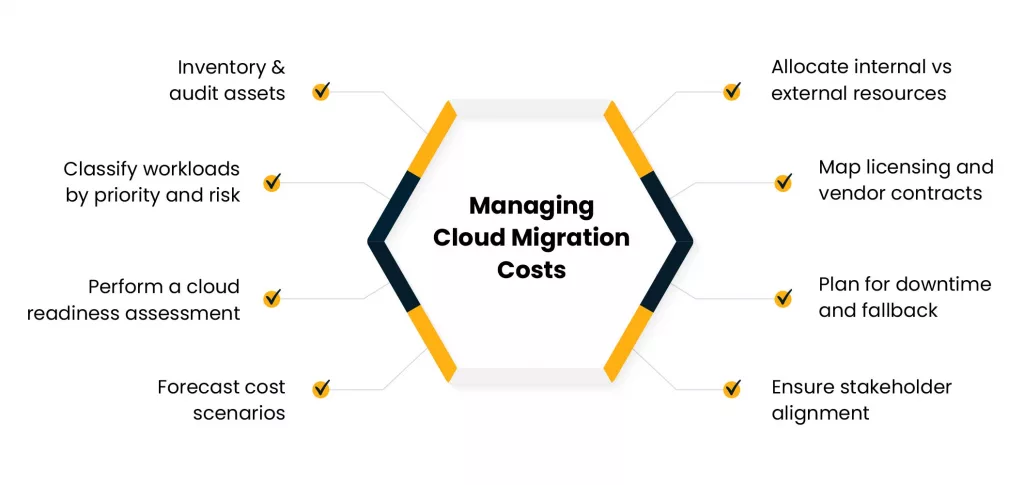Moving to the cloud is no longer an option for most businesses. It is something that’s already in motion or happening soon for them. But before anything shifts, one thing often slows teams down: the uncertainty around cost. It includes understanding what those costs mean — for daily operations and long-term planning.
Most teams are aware that the cloud changes how services run, how data is stored, and how easily systems scale. But in the rush to modernize, the financial side can get overlooked. The truth is, costs don’t begin and end with the migration itself. They can show up before the move even starts, continue during the transition, and keep surfacing well after the migration is done — which is why early cloud migration planning is critical.
That’s why it’s important to step back and look at the full picture. Where is the money going? What drives those expenses? And more importantly — what can be done to manage them without holding the business back?
In this blog, we’ll break down how cloud migration costs actually work, what influences them, how to plan with clarity, and which tools and services help keep spending under control throughout the entire process.
What are cloud migration costs, and how do they impact your financial planning?
When you read “cloud migration costs,” think of every expense involved. That often starts with the technical groundwork — moving servers and network components into a cloud environment. Then there’s the process of relocating your data and making sure your core business systems continue to run without disruption. Each step adds to the overall cost — a reminder that effective cloud migration services need both technical and financial governance.
These costs include:
- Infrastructure setup in the cloud (compute, storage, networking)
- Licensing changes or new software licenses
- Labor: internal staff plus external experts
- Data transfer, egress fees, and migration tools
- Downtime or loss of productivity during transition
- Training and change management
- Monitoring, governance, and post‑migration audits
Those costs matter because they affect your capital and operational budgets. If you underestimate them, your IT team will go over budget or delay business priorities. If you overestimate them, you may never take the leap, losing a competitive advantage. In effect, cloud migration costs must become part of your financial planning discussions from day one.
What key factors influence cloud migration costs for different businesses?
Every migration project is unique, and a range of factors can shape the overall level of your cloud migration costs. In fact, many organizations underestimate these variables during early planning.
One report found that 75% of businesses go over budget during cloud migration, and 28% exceed their budgets by at least 20%. This often happens when teams overlook the full cost implications tied to their current infrastructure, resource limitations, or compliance requirements.
The table below outlines some of the most common cost drivers and what they typically mean in practical terms:
| Factor | What It Means | Cost Impact |
| Existing infrastructure complexity | More legacy systems, interdependencies, custom code | Higher effort, more planning, more risk |
| Data volume and bandwidth | Large data sets, heavy databases | More data transfer costs, longer migration windows |
| Security, compliance, governance | Regulations (e.g. financial, health), encryption, audits | Higher design and validation costs |
| Cloud model choice | Public, private, hybrid, multi-cloud | Differences in unit pricing and overhead |
| Project timeline & resources | Speed required, internal vs external staff | Rush leads to premium costs |
| Use of cloud migration consultant | External expertise, tools, oversight | Adds cost but lowers risk and surprises |
How can cloud migration planning help manage costs effectively?
A well-defined cloud migration strategy becomes your defensive shield against budget shock and unplanned spend. This plan should begin early and cover both technical and financial dimensions. Below is a practical checklist you or your finance and IT teams can use when planning a migration.
Planning Checklist: Managing Cloud Migration Costs

- Inventory & audit assets
- List applications, servers, databases, dependencies, & usage.
- Identify unused or redundant assets.
- Classify workloads by priority and risk
- Choose noncritical workloads as pilots.
- Delay or defer highly risky components.
- Perform a cloud readiness assessment
- Check compatibility, data formats, and APIs.
- Note gaps in skill and design.
- Forecast cost scenarios
- Build best‑case, base, and worst‑case cost models.
- Include a buffer for surprises.
- Allocate internal vs external resources
- Decide what your team handles and what external consultants handle.
- Predict labor hours.
- Map licensing and vendor contracts
- See which on‑prem licenses transfer or expire.
- Check vendor terms for cloud transition.
- Plan for downtime and fallback
- Schedule migration windows.
- Plan rollback contingencies.
- Ensure stakeholder alignment
- Include finance, operations, IT, and business units.
- Agree on cost governance and reporting.
If you go through this checklist carefully, you will reduce surprises. Good planning anchors your financial expectations.
What are the best ways to control cloud migration costs during and after the move?
Even with planning, cost control during and after migration is crucial. Below are actionable methods to keep your budget under control:
Cost Control Methods
- Rightsize compute and storage: After migration, monitor usage. Scale down or eliminate idle VMs or disks.
- Use cost monitoring and tagging: Tag resources by project, team, or business unit. Use dashboards and alerts to track anomalies.
- Implement FinOps principles: Establish a cross‑functional team that monitors cost vs value continuously. Chargeback or showback models help accountability.
- Move to cloud-native services: Replace outdated applications with serverless, managed services, or container-based setups if feasible. This helps reduce overhead.
- Automate scaling and shutdown: Use auto-scaling or schedule shutdowns during low-usage hours for dev/test environments.
- Review data egress and transfer costs: Transfer within a region or use caching to reduce egress. Many cloud providers charge extra to move data across regions.
- Perform post-migration audits: Within the first 30–90 days, review all usage and unexpected bills. Adjust and refactor
Your cloud migration solutions should support all these methods with automation, cost tracking, and real-time visibility. Good solutions give you real-time cost visibility, alerts, governance controls, and automation support.
How do cloud migration solutions support long-term financial efficiency?
Long-term cost efficiency in the cloud doesn’t happen by accident. It requires structured support, operational discipline, and experienced guidance. Even after migration is technically complete, workloads evolve, usage increases, and new financial risks emerge. This is where cloud cost optimization plays a key role in ensuring sustainable financial efficiency after migration.
At Cygnet.One, these solutions are not limited to a one-time migration event. They include the full lifecycle of cloud transformation, from planning & execution to continuous monitoring & modernization.
Here are some of the core service components that support financial efficiency over time:
Visibility and alerts
Dashboards that show cost anomalies or usage spikes in real time. These insights help teams respond quickly before costs escalate.
Governance and policy enforcement
Enforce rules like denying resource creation beyond thresholds or enforcing tagging. This ensures accountability and minimizes the risk of unchecked spending.
Automated optimization suggestions
Tools can suggest underutilized instances, rightsizing, or reserved instance purchases. Continuous analysis helps maintain optimal resource usage without manual effort.
Migration orchestration and templates
Standard templates reduce manual errors and future rework. They also help apply consistent practices across environments and teams.
Security and compliance built in
Reduces the cost of audits or fixes later. Proactive alignment with industry standards lowers long-term risk and penalties.
Continuous cost benchmarking
Solutions compare your costs periodically, suggesting adjustments. This helps you align cloud spending with actual usage and business goals.
A cloud migration consultant helps implement these services, guides internal teams through adoption, and supports long-term alignment between technical design and financial goals. This partnership helps ensure that as your cloud environment grows, your spending stays rational and accountable.
In most cases, the return from these services offsets their costs. What you avoid in waste, inefficiency, and downtime adds quickly and creates real business value.
Make Cloud Migration a Cost-Controlled Success with Cygnet.One!
Managing cloud migration costs requires attention and structure. Careful planning, steady execution, and the right solutions help you stay in control of spending. This approach creates value that lasts well beyond the migration stage. Use the checklist to prepare, apply practical cost control measures during and after migration, and adopt cloud migration solutions that bring transparency and governance into your operations. Working with a trusted cloud migration consultant helps reduce risks and ensures your financial and technical goals stay aligned throughout the journey.
At Cygnet.One, we help businesses navigate migration with structured frameworks, cost efficiency, and modernization strategies. Our approach goes beyond migration — it enables sustainable operations in the cloud.
As one of our enterprise clients said:
Cygnet’s comprehensive approach to cloud transformation has been a game-changer for our business. They didn’t just help us migrate to the cloud; they enabled us to innovate and stay ahead of the competition.” — CEO, Multinational Corporation
When you start your next move to the cloud, your budget can be part of your success story, not a source of uncertainty.











